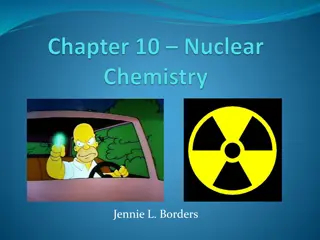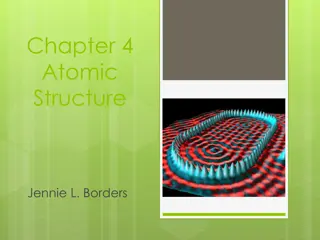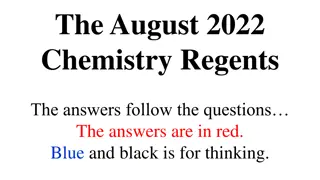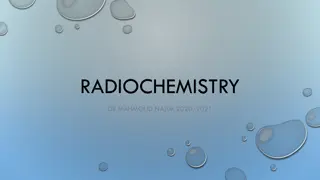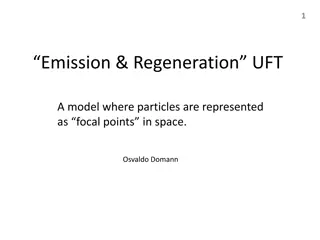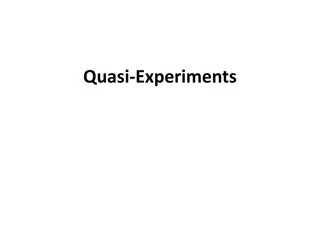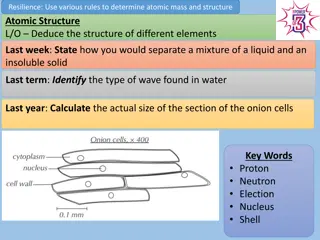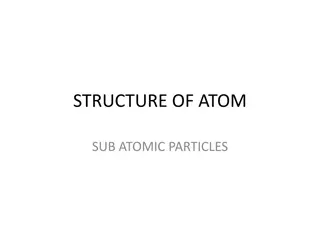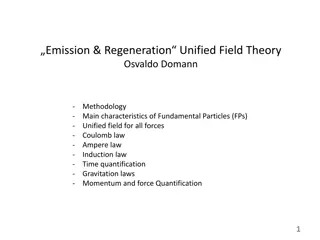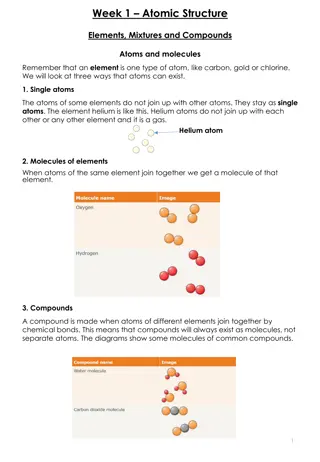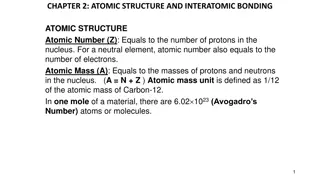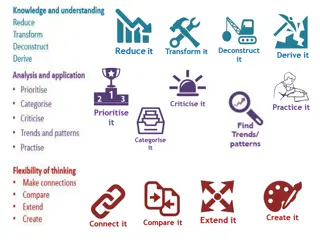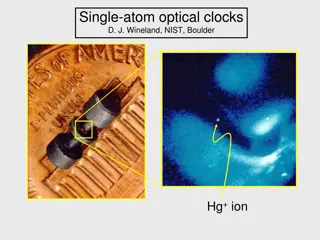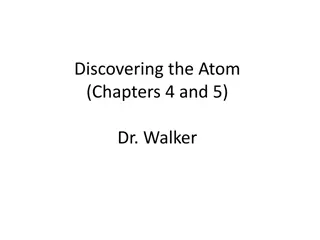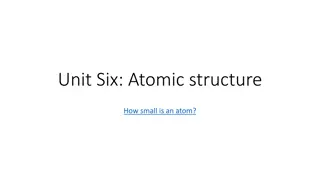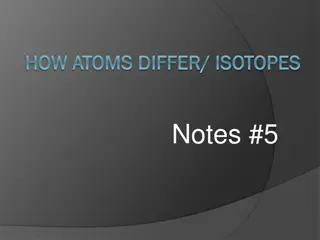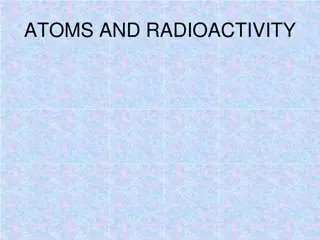Chemistry Regents June 2022 - Subatomic Particles and Atomic Experiments
Understanding subatomic particles, atomic experiments, and spectroscopy concepts in chemistry for the June 2022 Regents exam. Learn about particle charges, gold foil experiment conclusions, and bright-line spectrum elements.
Download Presentation

Please find below an Image/Link to download the presentation.
The content on the website is provided AS IS for your information and personal use only. It may not be sold, licensed, or shared on other websites without obtaining consent from the author. Download presentation by click this link. If you encounter any issues during the download, it is possible that the publisher has removed the file from their server.
E N D
Presentation Transcript
The June 2022 Chemistry Regents
1 Which subatomic particles are matched with their charges? (1) Protons are positive and neutrons are negative. (2) Protons are positive and electrons are negative. (3) Protons are negative and neutrons have no charge. (4) Protons are negative and electrons have no charge.
1 Which subatomic particles are matched with their charges? (1) Protons are positive and neutrons are negative. (2) Protons are positive and electrons are negative. (3) Protons are negative and neutrons have no charge. (4) Protons are negative and electrons have no charge. You must know this: protons are positive, neutrons are neutral, and electrons are negative. And, protons and neutrons are in the nucleus, electrons fly around outside, all atoms are neutral since they all have equal numbers of positive protons and negative electrons. The choices 3 and 4 are OUT. Looking again at #1 and 2, #1 is wrong, this has to be #2.
2 Which conclusion directly resulted from the gold foil experiment ? (1) Atoms are mostly empty space. (2) Atoms are hard, indivisible spheres. (3) Electrons are located in shells. (4) Electrons have a small mass.
2 Which conclusion directly resulted from the gold foil experiment ? (1) Atoms are mostly empty space. (2) Atoms are hard, indivisible spheres. (3) Electrons are located in shells. (4) Electrons have a small mass. You must know this: Rutherford did the gold foil experiment where he shot alpha particles from radioactive polonium at a very thin sheet of gold foil. He could detect these + alpha particles with a special screen. The alpha particles go straight, so no foil, they go directly into the detecting screen. When he put the gold foil in the way nearly all went right through it again. That means the atoms of gold (all atoms) are mostly empty space. 2 according to the KMT 2 is correct in theory, but not due to this experiment. 3 electrons are in orbitals casually called shells, not due to this experiment 4 electrons have the tiniest of mass, zero in high school, but not due to this experiment
3 The bright-line spectrum of an element is produced when excited-state electrons (1) absorb energy and move to higher energy states (2) absorb energy and move to lower energy states (3) release energy and move to higher energy states (4) release energy and move to lower energy states
3 The bright-line spectrum of an element is produced when excited-state electrons (1) absorb energy and move to higher energy states (2) absorb energy and move to lower energy states (3) release energy and move to higher energy states (4) release energy and move to lower energy states You must know this: We did this in the electrons lab, we saw the spectra coming out of the lamps, and we saw the fires burning ON THE SALTS, which were different colors. Energy does have to be absorbed to excite the electrons from ground to the excited state, but SPECTRA is produced when excited electrons release energy to return back to the ground state.
4 The elements on the Periodic Table of the Elements are arranged in order of increasing (1) atomic mass (2) atomic number (3) mass number (4) oxidation state
4 The elements on the Periodic Table of the Elements are arranged in order of increasing (1) atomic mass (2) atomic number (3) mass number (4) oxidation state You must know this: Hydrogen is #1 and the numbers go all the way to #118, by ATOMIC NUMBER. The atomic number is the number of positive protons in that atom, and it s also the number of negative electrons, since all atoms are electrically neutral (the positives = the negatives)
5 Atoms of which element in Group 15 have the greatest electronegativity? (1) As (2) Bi (3) N (4) P
5 Atoms of which element in Group 15 have the greatest electronegativity? Electronegativity values 2.2 1.9 3.0 2.2 (1) As (2) Bi (3) N (4) P Atoms As Bi N P You must know this: first make a chart, then take out table S and put the electronegativity values in order, and LOOK. Put your finger into the right box. Note these are not in order top to bottom, they hate you and want you to guess. It s N.
6 Which term represents the simplest whole number ratio of atoms of the elements in a compound? (1) atomic mass (2) formula mass (3) empirical formula (4) structural formula
6 Which term represents the simplest whole number ratio of atoms of the elements in a compound? Molecular Empirical (1) atomic mass (2) formula mass (3) empirical formula (4) structural formula C6H12O6 CH2O C8H18 C4H9 CO2 CO2 You must know this: atomic mass is the total number of protons PLUS neutrons in an atom. Formula mass (gram formula mass) is really molar mass. Structural formulas are for organic molecules, they look like this It s empirical, one of the dumbest things of the year, just math reductions with on other real chemical value to us.
7 How many electrons are shared in a triple bond between two atoms? (1) 6 (2) 2 (3) 3 (4) 4
7 How many electrons are shared in a triple bond between two atoms? (1) 6 (2) 2 (3) 3 (4) 4 You must know this: in a triple bond there are THREE BONDS between 2 atoms. Each bond requires each atom to share one electron each, so there are SIX ELECTRONS shared in a triple bond. Answer the right question, here it s how many total electrons.
8 Given the equation representing a reaction: Cl2 Cl + Cl What occurs during this reaction? (1) Energy is released as a bond is broken. (2) Energy is released as a bond is formed. (3) Energy is absorbed as a bond is broken. (4) Energy is absorbed as a bond is formed.
8 Given the equation representing a reaction: Cl2 Cl + Cl What occurs during this reaction? (1) Energy is released as a bond is broken. (2) Energy is released as a bond is formed. (3) Energy is absorbed as a bond is broken. (4) Energy is absorbed as a bond is formed. You must know this: This question is ALWAYS on the exam. Here, a bond is broken the molecule is separated into 2 loose atoms. That is hard, it takes energy. We try to remember the opposite: Cl + Cl Cl2 When bonds form, energy is released. This is the opposite: a bond is breaking, energy is absorbed.
9 Krypton atoms in the ground state tend not to bond with other atoms because their (1) second electron shell contains eight electrons (2) third electron shell contains eighteen electrons (3) innermost electron shell contains two electrons (4) outermost electron shell contains eight electrons
9 Krypton atoms in the ground state tend not to bond with other atoms because their (1) second electron shell contains eight electrons (2) third electron shell contains eighteen electrons (3) innermost electron shell contains two electrons (4) outermost electron shell contains eight electrons You must know this: Krypron is a noble gas. Noble gases tend to make NO BONDS with other atoms because they are already PERFECT . That means all of their electron orbitals are full, and they cannot accept electrons in a bond, nor do they want to share their electrons. Choices 1, 2 and 3 are all correct, but NOT the reason. The outermost orbital is FULL, as is helium with just 2 electrons (it s too small for 8, but it s FULL).
10 All matter can be classified as (1) an element (2) a compound (3) a mixture or an element (4) a mixture or a substance
10 All matter can be classified as (1) an element (2) a compound (3) a mixture or an element (4) a mixture or a substance You must know this: elements are the simplest form of substances, they can t be broken down into simpler substances. Compounds are 2 or more bonded atoms, they can be broken down into simpler substances. Matter can be pure (elements & compounds) or mixed (either atoms and atoms, or atoms and compounds)
11 Which sample at STP has the same chemical properties as 10. grams of Al(s) at STP? (1) 10. grams of Si(s) (2) 10. grams of Na(s) (3) 5 grams of Al(s) (4) 5 grams of Mg(s)
11 Which sample at STP has the same chemical properties as 10. grams of Al(s) at STP? (1) 10. grams of Si(s) (2) 10. grams of Na(s) (3) 5 grams of Al(s) (4) 5 grams of Mg(s) You must know this: Chemical properties are similar in the groups of the periodic table, or identical with samples of the same substance. Here, same chemical properties as aluminum has to be MORE ALUMINUM. Si, Na, and Mg are different elements with different properties.
12 Which sample of matter can not be broken down by a chemical change? (1) antimony (2) ethanol (3) methane (4) water
12 Which sample of matter can not be broken down by a chemical change? Number of kinds of atoms present Choices Formula (1) antimony (2) ethanol (3) methane (4) water Sb Antimony Just ONE C2H5OH CH4 H20 Ethanol C, H and O Methane C and H water H and O You must know this: compounds can be broken down, elements cannot. Write the formulas, it will help you think. Here, antimony is just Sb, the other three can all decompose into separate atoms.
13 Based on Table F, which 10.-gram sample, when thoroughly mixed with 1 liter of water at room temperature, forms a heterogeneous mixture? (1) ammonium chloride, NH4Cl (2) potassium iodide, KI (3) silver bromide, AgBr (4) sodium nitrate, NaNO3
13 Based on Table F, which 10.-gram sample, when thoroughly mixed with 1 liter of water at room temperature, forms a heterogeneous mixture? (1) ammonium chloride, NH4Cl (2) potassium iodide, KI (3) silver bromide, AgBr (4) sodium nitrate, NaNO3 You must know this: Table F tells soluble which is AQUEOUS, or insoluble which means forms a precipitate, or won t dissolve at all in water. If you re first name is ammonium = AQ. Group 1 ions make AQ too. (K+1 or Na +1) Halides with Ag+1 are insoluble, not AQ.
14 Compared to a 1.0 M NaCl(AQ) solution at 1.0 atm, a 2.0 M NaCl(AQ) solution at 1.0 atm has (1) a lower boiling point and a lower freezing point (2) a lower boiling point and a higher freezing point (3) a higher boiling point and a lower freezing point (4) a higher boiling point and a higher freezing point
14 Compared to a 1.0 M NaCl (AQ) solution at 1.0 atm, a 2.0 M NaCl(AQ) solution at 1.0 atm has (1) (2) (3) (4) a lower boiling point and a lower freezing point a lower boiling point and a higher freezing point a higher boiling point and a lower freezing point a higher boiling point and a higher freezing point 2.O M NaCl(AQ) 1.O M NaCl(AQ) Has 2 moles of ions Has 4 moles of ions in solution. in solution. Draw a picture to think You must know this: More ions in solutions make the boiling point increase (BP elevation). More ions in solution make the freezing point lower (FP depression). Here we need BOTH HIGHER BOILING POINT and LOWER FREEZING POINT.
15 Which list includes three forms of energy? (1) temperature, chemical, thermal (2) temperature, thermal, alkalinity (3) electromagnetic, nuclear, chemical (4) electromagnetic, alkalinity, nuclear
15 Which list includes three forms of energy? (1) temperature, chemical, thermal (2) temperature, thermal, alkalinity (3) electromagnetic, nuclear, chemical (4) electromagnetic, alkalinity, nuclear You must know this: Energy comes in many forms; and energy can be transferred from one form to another. Temperature is a measure of thermal energy, so Temperature is OUT. Alkalinity is a vocab word from Acid/Base chem, meaning how basic a solution is, also OUT.
16 Under which conditions of pressure and temperature is a real gas most like an ideal gas? (1) low pressure and low temperature (2) low pressure and high temperature (3) high pressure and low temperature (4) high pressure and high temperature
16 Under which conditions of pressure and temperature is a real gas most like an ideal gas? (1) low pressure and low temperature (2) low pressure and high temperature (3) high pressure and low temperature (4) high pressure and high temperature You must know this: the worst thing that can happen to a gas is that it turns into a liquid (ugh!) or a solid (groan!). Conditions that encourage gases to NOT do that keep it a gas, and that is MORE IDEAL. High Temps mean harder collisions, less likelihood of collapsing into a liquid, and Low Pressures mean less collisions, again, less likelihood of collapsing into a liquid.
17 Which sample of argon gas has the same number of atoms as a 100.-milliliter sample of helium gas at 1.0 atm and 300. K? (1) 50. mL at 1.0 atm and 300. K (2) 50. mL at 0.5 atm and 300. K (3) 100. mL at 0.5 atm and 300. K (4) 100. mL at 1.0 atm and 300. K
17 Which sample of argon gas has the same number of atoms as a 100.-milliliter sample of helium gas at 1.0 atm and 300. K? (1) 50. mL at 1.0 atm and 300. K (2) 50. mL at 0.5 atm and 300. K (3) 100. mL at 0.5 atm and 300. K (4) 100. mL at 1.0 atm and 300. K You must know this: Avogadro s Hypothesis. Equal volumes of different gases at the same temperature and pressure, have the same number of particles and the same number of moles. No math. You need 100 mL of a gas at the same initial conditions: 1.0 atm pressure, and 300. Kelvin temp.
18 Which process is a chemical change? (1) condensation of H2O(G) (2) synthesis of MgO(S) (3) evaporation of C2H5OH(L) (4) sublimation of CO2(G)
18 Which process is a chemical change? (1) condensation of H2O(G) (2) synthesis of MgO(S) (3) evaporation of C2H5OH(L) (4) sublimation of CO2(G) You must know this: condensation is gas to liquid phase change (physical change) Evaporation is liquid to gas phase change (physical change) Sublimation is solid to gas phase change (physical change) Synthesis is when 2 kinds of atoms form a compound with new properties and and a new formula 2Mg + O2 2MgO (balanced)
19 Which property is determined by the structure, arrangement, and interactions of the molecules of a substance at a given temperature and pressure? (1) atomic radius (2) half-life (3) formula mass (4) physical state
19 Which property is determined by the structure, arrangement, and interactions of the molecules of a substance at a given temperature and pressure? (1) atomic radius (2) half-life (3) formula mass (4) physical state You must know this: atomic radius is the distance from center of nucleus to edge of outer orbital in picometers. Half life is how long in time it takes for one half of a radioactive sample to decay. Formula mass means molar mass. Physical state means solid, liquid or gas, which of course is impacted by temperature and pressure. most often, lower temps = liquids or solids, high pressure the same. Highest temperatures = gas phase, lower pressures also force the gas phase.
20 A collision between reactant particles is most likely to result in a reaction when the particles have proper orientation and proper (1) charge (2) energy (3) mass (4) radius
20 A collision between reactant particles is most likely to result in a reaction when the particles have proper orientation and proper (1) charge (2) energy (3) mass (4) radius You must know this: for a reaction to occur, particles must collide with proper orientation and sufficient energy (but not too much or they bounce apart). Anything that increases the rate of collisions will speed up a reaction.
21 Given the equation representing a system at equilibrium: 2NO2(g) N2O4(g) Which statement describes this reaction at equilibrium? (1) The concentration of the reactant & product must be equal. (2) The concentration of the reactant & product must be constant (3) The rates of the forward and reverse reactions are increasing. (4) The rates of the forward and reverse reactions are decreasing.
21 Given the equation representing a system at equilibrium: 2NO2(g) N2O4(g) Which statement describes this reaction at equilibrium? (1) The concentration of the reactant & product must be equal. (2) The concentration of the reactant & product must be constant (3) The rates of the forward and reverse reactions are increasing. (4) The rates of the forward and reverse reactions are decreasing. You must know this: dynamic equilibrium means that the rate of the forward reaction equals the rate of the reverse. If this is the case, it appears that nothing is happening because the amount of reactant on the left of the double arrow stays constant to the amount of product on the right. Constant amounts do NOT have to be equal amounts.
22 Which phrase describes the effect of adding a catalyst to a chemical reaction in order to increase the reaction rate? (1) provides a different reaction pathway with a lower activation energy (2) provides a different reaction pathway with a higher activation energy (3) uses the same reaction pathway with a higher activation energy (4) uses the same reaction pathway with a lower activation energy
22 Which phrase describes the effect of adding a catalyst to a chemical reaction in order to increase the reaction rate? (1) provides a different reaction pathway with a lower activation energy (2) provides a different reaction pathway with a higher activation energy (3) uses the same reaction pathway with a higher activation energy (4) uses the same reaction pathway with a lower activation energy You must know this: Catalysts make reactions go faster by LOWERING THE ACTIVATION ENERGY, or PROVIDING AN ALTERNATE CHEMICAL PATHWAY, with A LOWER ENERGY REQUIREMENT, OR BOTH.
23 Systems in nature tend to undergo changes toward (1) lower energy and less disorder (2) lower energy and greater disorder (3) higher energy and less disorder (4) higher energy and greater disorder
23 Systems in nature tend to undergo changes toward (1) lower energy and less disorder (2) lower energy and greater disorder (3) higher energy and less disorder (4) higher energy and greater disorder You must know this: This is always on the exam The universe is breaking down into disorder, things are separating apart (not being put back together again). That s HIGHER ENTROPY. Energy is spreading out, not recollecting.
24 Which element must be present in an organic compound? (1) carbon (2) sulfur (3) nitrogen (4) oxygen
24 Which element must be present in an organic compound? (1) carbon (2) sulfur (3) nitrogen (4) oxygen You must know this: To be organic, the first atom in the formula has to be carbon. Carbon is the FIRST WORD in the organic chem textbook.
25 Which formula represents a saturated hydrocarbon? (1) C2H2 (2) C2H4 (3) C6H10 (4) C6H14


